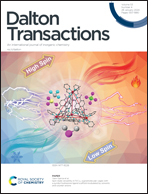A rhodium(ii)/rhodium(iii) redox couple for C–H bond amination with alkylazides: a rhodium(iii)–nitrenoid intermediate with a tetradentate [14]-macrocyclic ligand†
Abstract
The catalytic activity of a rhodium(II) dimer complex, [RhII(TMAA)]2 (TMAA = tetramethyltetraaza[14]annulene), in C–H amination reactions with organic azides is explored. Organic azides (N3–R) with an electron-withdrawing group such as a sulfonyl group (trisylazide; R = S(O)2iPr3C6H2 (Trs)) and a simple alkyl group (R = (CH2)4Ph, (CH2)2OCH2Ph, CH2Ph, or C6H4NO2) are employed in intra- and intermolecular C–H bond amination reactions. The spectroscopic analysis using ESI-mass and EPR spectroscopy techniques on the reaction intermediate generated from [RhII(TMAA)]2 and N3–R reveals that a rhodium(III)–nitrenoid species is an active oxidant in the C–H bond amination reaction. DFT calculations suggest that the species can feature a radical localised nitrogen atom. The DFT calculation studies also indicate that the amination reaction involves hydrogen atom abstraction from the organic substrate R′–H by the NR moiety of 2N˙R and successive rebound of the generated organic radical intermediate R′˙ to [RhIII(NH–R)(TMAA)], giving [RhII(TMAA)] and R′–NH–R (amination product).
![Graphical abstract: A rhodium(ii)/rhodium(iii) redox couple for C–H bond amination with alkylazides: a rhodium(iii)–nitrenoid intermediate with a tetradentate [14]-macrocyclic ligand](/en/Image/Get?imageInfo.ImageType=GA&imageInfo.ImageIdentifier.ManuscriptID=D3DT03429A&imageInfo.ImageIdentifier.Year=2024)


 Please wait while we load your content...
Please wait while we load your content...